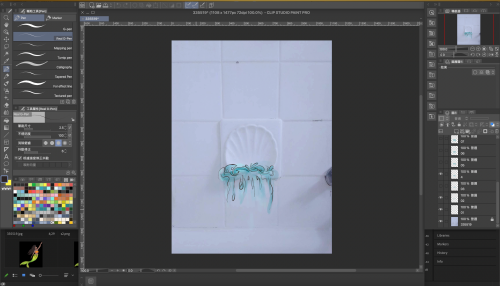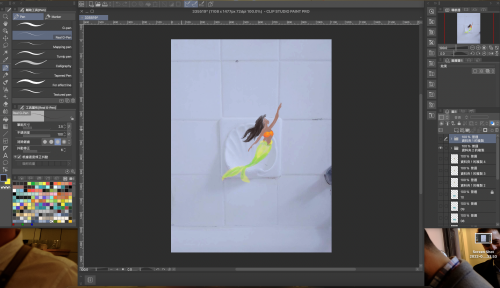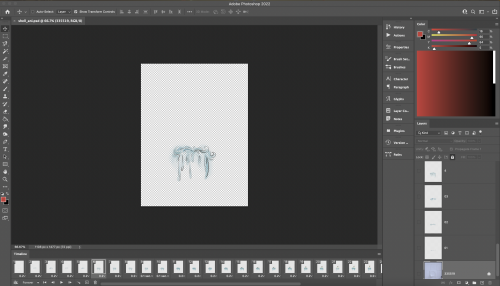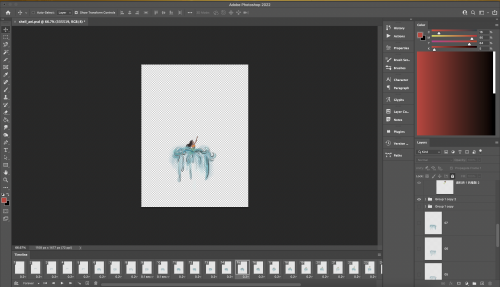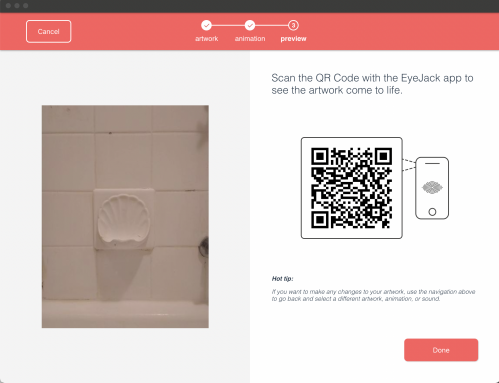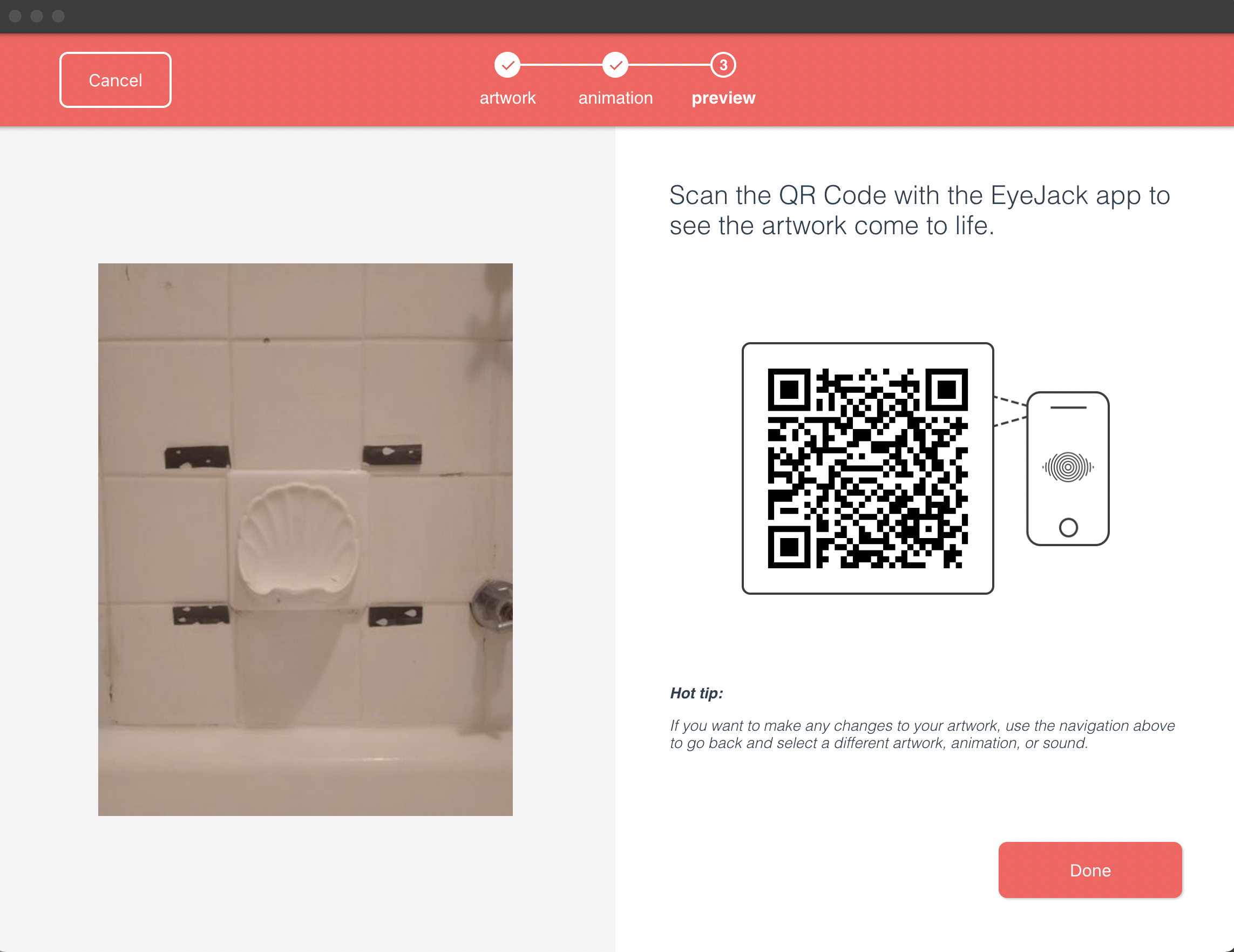
Theme: Play and Object
Context:
This week’s theme, play and object reminds me of having imaginary friends when I was a kid. I had imaginary friends and I would interact with them with objects and surroundings. For the theme this week, I would like to recreate the play with imaginary friends and visualize the experience and share with real friends.
Method:
- Pick objects in the house
- Create an animation showing the imaginary friend associate with the object
- Use AR (EyeJack) to reveal the imaginary friend hiding in the house and share with housemate
The object used for this project is a shell shape soap holder in the house. The theme is about a mermaid / fairy that lives in our bathroom. The soap holder is her hideout. You can go to her hideout and ask her to come out to play.
The goal is to share that we have a mermaid firmed in our house with my housemate. I first take a picture of the soap holder and used the photo as the base layer to create the animation. I used Clip Studio Paint to create the frames of the mermaid coming out of the water from the soap holder and set them up in photoshop. For setting up the scene, I installed EyeJack creator on laptop to put together the object / mermaid hideout and animation. By using EyeJack app, the mermaid animation will be triggered when the phone scan the soap holder on the wall.
Reflection:
I enjoyed working on this project. The experience is like playing with my imaginary friend when I was a kid, but now I am able to share the exciting experience with “real stuff” with others. It is also interesting to see the relationship between an object a narrative (the old-school pretending game) and see others’s responses when they see “your imagination”. The kid’s play, where we often played with toys or any kind of objects, is often based on imagination. With the objects I use (a phone and an app), others can see and hear what I created. Seeing my housemate interacting with the AR friend in our bathroom is like we both to get to play with my imaginary friends. The phone is like a pair of special glass with magic that revels the hiding friends around us.
With the projects I have worked on in ADP so far, I observe that when I think of the idea “play”, I often look into the pattern how I used to play as a kid unconsciously. This project, where I share my “imaginary friend”, leads me looking into the psychology theory behind having imaginary friends for kids. Researches indicates that having imaginary friends has many benefits, such as coping with stress and conflict, improving problem-solving skills, and adding social development as well as improving a child’s theory of mind. Theory of mind, which kids usually develop around age of 4 or 5, is the ability to understand that others have different thoughts and feelings than they. Researches also state that first borns and girls are more likely to have imaginary friends. Having imaginary friends is a rich form of role-play, where the kids have to take on the persona of the imaginary friend. Studies show that kids who have imaginary friends tend to be more creative than those who don’t have make-believe friends.
After the feedback and discussion during class, I was fascinated how my mind work. I realized that my mind recall the sense of comfort and excitement when I repeat the old pattern of play. Imaginary friend for me is a solution of escaping reality and stress and also shapes me into a creative designer.
I can see the potential for this project to be further developed. It was my first time working with AR and EyeJack. I was surprised that it’s quite easy to set up a scene with the apps. I think a more finish-up transparent version of the animation would work better for this project. I can also see many other objects in the house with hidden friends. Unfortunately, I did not have enough time to create enough AR animations with the objects. It would be very exciting to see a number of animations hidden in our space and the guests get to discover and interact with them when they visit.
Reference:
Volpe, A. (2019, July 30). Why kids invent imaginary friends. The Atlantic. Retrieved March 26, 2022, from https://www.theatlantic.com/family/archive/2019/07/why-do-kids-have-imaginary-friends/594919/
Davis, P. E., Meins, E., & Fernyhough, C. (2013, August 24). Individual differences in children's private speech: The role of imaginary companions. Journal of Experimental Child Psychology. Retrieved March 26, 2022, from https://www.sciencedirect.com/science/article/pii/S0022096513001331?via%3Dihub
The Brainwaves Video Anthology. (2016). Imaginary Companions and the Children Who Create Them. YouTube. The Brainwaves Video Anthology. Retrieved March 26, 2022, from https://youtu.be/vO2A4KAH3EQ.
Schwarz, J. (2004, December 9). Imaginary friends: Most kids have one (or more). UW News. Retrieved March 26, 2022, from https://www.washington.edu/news/2004/12/09/imaginary-friends-most-kids-have-one-or-more/
Redbubble in Augmented Reality - Redbubble x EyeJack Collaboration https://youtu.be/2lat70Aa3tU
Project Outcome: https://youtu.be/M3pjQahOdhg
About This Work
By Gin Lin
Email Gin Lin
Published On: 23/03/2022

